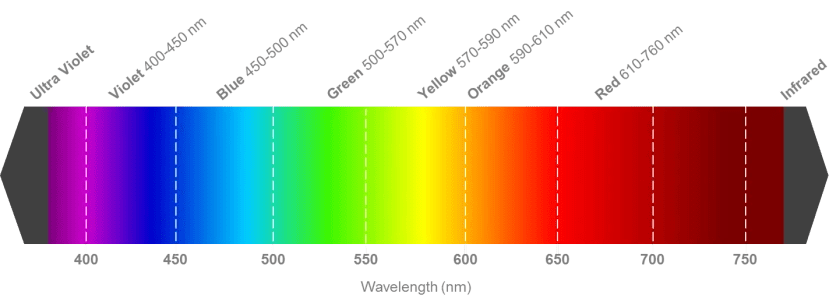- Home
- Community
- Community Content
- All Technologies
- LED Lighting
- LED Wavelength vs. LED Colour
0star_border 0question_answer 0thumb_up
![]() Dave from DesignSpark
Dave from DesignSpark
How do you feel about this article? Help us to provide better content for you.
![]() Dave from DesignSpark
Dave from DesignSpark
Thank you! Your feedback has been received.
![]() Dave from DesignSpark
Dave from DesignSpark
There was a problem submitting your feedback, please try again later.
![]() Dave from DesignSpark
Dave from DesignSpark
What do you think of this article?
What is wavelength?
Wavelength is used to differentiate coloured, UV and IR LEDs, but not white LEDs. The wavelength of an LED is determined by the semiconductor material used within it. When choosing your LED, the wavelength value will give you an idea of the colour of the light it’s going to emit.
Choosing an LED Colour
Colour descriptions can sometimes be misleading, especially as new colours evolve. They often have interesting names such as “pinkish-blue” (is that just purple?). Another issue could be, after ordering the orange LEDs for your panel indicators, you light it up and it looks red. This is because the LED has a higher wavelength, perhaps around 625nm. The secret often lies in the terminology, such as “True”, “Deep” and “Hyper”, but that isn’t always the best thing to go by. Take the wavelength value given in nanometres (nm) and compare it against a colour chart:
The wavelength will tell you the colour of the LED light, but I would still take the “try before you buy” approach. Never go ahead with mass production before you have seen how it looks in person. Imagine it’s like painting a room, you always try a sample first, as even the environment it is in can change how it’s going to look.
Lenses - tinted or clear?
Another factor to consider is the colour of the LED package or lens. Blue LEDs can have either a blue tinted lens or a colourless lens. One of the main considerations here is how you want the LED to appear when it is off. Surface mount LEDs often have a white package; however some do have a black package which enables higher on/off contrast, great for use in displays.
White LEDs
As mentioned earlier, white LEDs cannot be differentiated by wavelength. They appear “cool”, “neutral” or “warm” white due to their colour temperature, measured in Kelvin (K).
For a better understanding of the technology behind wavelength, take a look at this page by OSRAM Opto Semiconductors: Light Colours
Visible LED range at RS Components
Related Posts - Choosing a White LED
Share this post
AmyPrattis has not written a bio yet…

